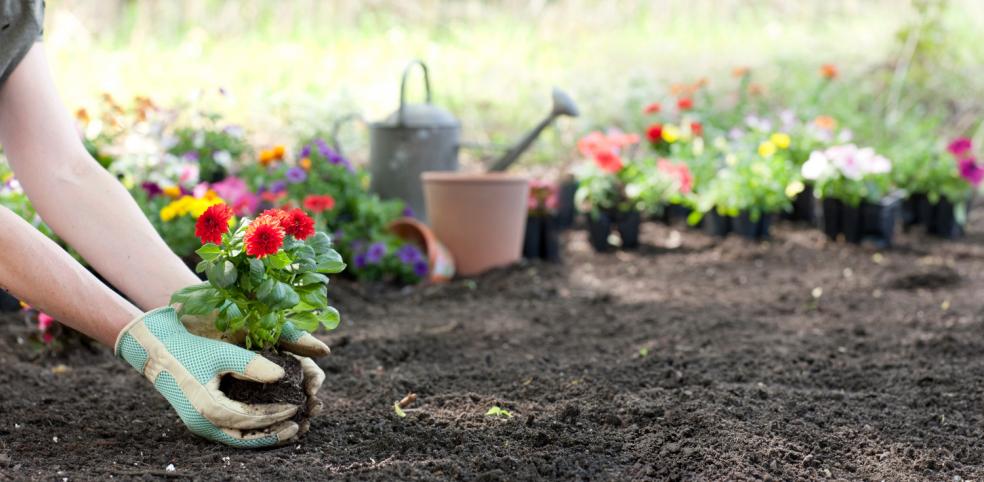
Got a garden for the first time? 9 of the easiest things beginners should start with
If you've never had a garden before, it's a real revelation when you finally move into somewhere with a patch of grass to call your own – space to potter around in, barbecues in the summer and drinks in the fading evening light.
But for people who've never so much as bought a pair of garden gloves and pulled a weed out, suddenly having to care for and nurture a garden year-round can be daunting.
So before the autumn threatens to dump an additional leaf problem on your garden, here are some of the simplest ways you can take control of your new patch of land – and engage in a spot of therapeutic outdoor activity.
BBC Gardeners' World presenter Mark Lane shares his advice for newbies...
1. Don't do anything right away
Lane says: "Wait and see where the sun rises and sets, where the shade lies, where the wind blows, and if you are moving into an established garden, what plants come up before you change anything."
2. Check your soil
The key to a blooming garden is a healthy soil, so what are the signs that it's unhealthy? "If it looks light in colour and full of sand and is lightweight, or heavy and full of clay," Lane says. "Check to see if your soil is full of worms. If so, then it's probably teaming with life, which is a good thing."
But the easiest thing to do is buy a pH soil tester at your local garden centre. "This will establish whether your soil is acidic, neutral or alkaline, to work out which plants will thrive. Magnolias, rhododendrons, camellias all prefer slightly acidic soils," says Lane. "Garden centres will usually signpost which plants like which soils to make buying easy."
3. Know when to mow
Looking out onto a neat, luscious green lawn is probably probably one of the reasons you wanted a garden in the first place, so how do you get it looking tip-top? Well, how often you mow will depend on the time of year and the weather.
"If in doubt, mow once a week during spring and autumn, and twice weekly during summer – although once a week from spring to autumn may suffice. Mowing is not necessary during winter, especially not if the ground is frozen," says Lane. "Aim to cut no more than a third of the leaf blade, and don't set the mower too low or scalp the turf."
4. Plant in groups
"Keep things simple and aim to plant in blocks of three, fives or seven of the same type of plant to create wonderful blocks of colour and texture," he suggests.
"All plants like free-draining soils, which can also hold some moisture. Add homemade (ideal) or bought compost before planting – this will help improve drainage on clay soil and encourage moisture retention on sandy soils.
"Mulch after planting – by covering the soil with a 5cm layer of compost around the base of the new plants. Then water well."
5. Sow seeds
You can't go wrong here. "If you're on a tight budget, sow seeds. Follow the instructions on the packets as to how you prepare your soil, and you can create an almost instant garden for around £10," he says.
6. Start with easy-to-grow veg and herbs
If you fancy yourself as a bit of a kitchen gardener, Lane says radish, carrots and lettuce are the quickest and simplest to grow.
"Oregano is great for cooking and attracting wildlife, and thyme, sage and chives," he says. "Generally, herbs like a gritty compost so add plenty of horticultural grit when planting, while vegetables prefer nutrient-rich soils with no stones."
7. Flowers aren't tricky either
Don't just choose whatever looks pretty – there are other factors to consider. "Try nepeta (catmint) as a brilliant alternative to lavender, which can often get a bit woody," Lane suggests, "Rudbeckia (coneflower) and sunflowers too."
He says herbaceous perennials (a plant whose growth dies down annually but whose roots or other underground parts survive) like nutrient-rich soils that will not dry out with a pH of 6.5, while wildflowers like low-nutrient soil (i.e. the subsoil) and most will grow with a neutral pH7.
8. Choose these easy-to-care-for shrubs
"Abelia x grandiflora, which flowers from June to September, is a wonderful evergreen shrub," says Lane. "It's semi-evergreen, so will give shape and texture even during the winter months and the flowers are also fragrant. Grow it in the shelter of a wall or towards the back of a border.
"Choisya x dewitteana Aztec pearl is fully hardy, evergreen, and flowers in May and often late summer. It can also be grown in partial shade. The leaves get damaged by exposure to strong winds or frost, but this won't kill the plant.
"Pyracantha, again, is fully hardy and evergreen, with small white flowers in late spring and fantastic berries in autumn that attract birds and wildlife."
All three are easy to care for and can be pruned to keep their shape. "If a shrub has got too large for its spot, or branches are crossing, dead, diseased or damaged then prune to keep the plants in shape and healthy. You want to have an open middle so that air can pass through the shrub, to help prevent pests and diseases."
9. Don't over water
Most people over water, Lane says. If a plant needs water it might be wilting or have flowers hanging downwards. "If in doubt, dig a small 'pit' next to the plant and fill with water – see how quickly the water drains away," he adds.
"If planting a dry garden, which will require less watering, then go for plants that will thrive in dry, arid conditions, such as Achillea, Artemisia, Agapanthus.
"If you're feeling more adventurous, then divide the garden into different zones and grow plants with similar growing conditions in each zone."













